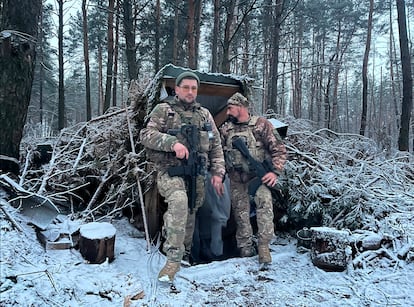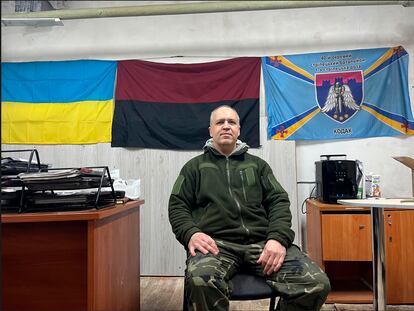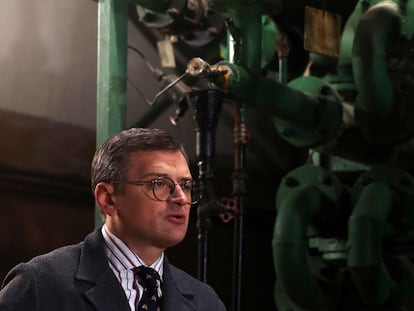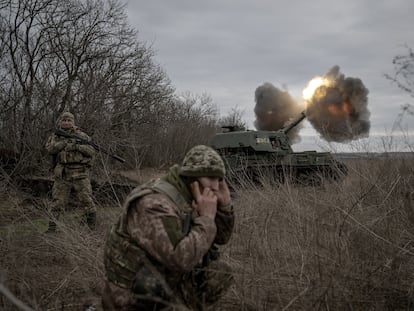Ukrainian resistance against Russia in the frozen trenches of Kupiansk: ‘They launch constant attacks’
The Kremlin has stepped up its offensive on the stronghold of the town, which it took with little effort in the opening stages of the invasion, but was recaptured by Ukraine’s army in September 2022


Major Nafania advances through the snow-covered forest at a steady pace. Just two years ago, this miner with a narrow smile, born in the central Dnipropetrovsk region, could not imagine himself like this, with a rifle on his shoulder, in an icy trench on the eastern front of Kupiansk, with a brigade made up of other miners, warehouse managers, operators, a store manager, drivers, a financial analyst... all turned into military men, holding one of the hottest positions on the extensive front line of Russia’s war against Ukraine. Nafania, the nom de guerre of the commanding officer of the 40th Separate Rifle Brigade (Kodak), points to a hole in the ground where the trees are bleached. And another one beyond. “These are the remains of the Russians. This area was occupied, now they want it back,” he mumbles. A buzzing sound precedes the explosion of a missile. The artillery barrage thunders. The Russian positions are a little over a mile away. The Kremlin wants to encircle this whole sector and is giving the defender no respite.
The Kremlin has stepped up its offensive on the stronghold of Kupiansk, some 25 miles from the Russian border, a town it took with little effort in the opening stages of the invasion and which the Ukrainian army recaptured in September 2022. Moscow used the town — of around 60,000 inhabitants before the war — and the rest of the area as a major logistics hub. Now it wants to recapture it and use it as leverage to take control of the entire Luhansk region (which it almost completely occupies) and from there march into the north of the Donetsk region. It also seeks to use it as a springboard to advance towards Kharkiv — before the war, the second most-populated city in Ukraine — and to achieve a better position to punish a locality that Vladimir Putin coveted from the outset of the invasion and that in recent days Russian forces have been trying to hit with storms of missiles and drones.
According to analysts, Russia is focusing one of its most significant efforts of the war on the Kupiansk front. Chechen special forces and several Russian motorized rifle units are operating all along the line to the occupied city of Kreminna. Moscow is now preparing to reinforce its push with up to 5,000 more men, several Ukrainian military observers explain. Russia has advanced a few meters — “marginally,” experts say — since it re-launched the offensive last October to distract Ukrainian troops from the counteroffensive to the south, which has ultimately failed.
“They launch constant attacks; they try to advance and if their comrades fall, they don’t even come back to pick up their corpses,” says Nafania. “I still can’t figure out what their motivation is,” says the 34-year-old officer, nicknamed after a character from a Soviet-era animated film. The 40th Separate Rifle Brigade, formed as part of the Territorial Defense Forces in the early stages of the invasion, was integrated into the Ukrainian regular army and is now deployed with other units in the area, dotted with villages and forests and surrounded by mazes of trenches.
After nearly two years of war, Putin maintains his objective of subduing Ukraine. “He wants to occupy the whole country, and he has launched an all-out operation to take Donbas, in the east,” says Mikhail Samus, a reputed Ukrainian military analyst. “They are trying to break through in different directions from the north, east, and south at the same time,” he explains by phone. Samus doubts the strategic importance of Kupiansk, and the whole area, for Moscow. “They occupied that area for six months, and it didn’t do any good; besides, if they only succeed in one direction, it doesn’t matter. From the operational point of view, it is absurd,” adds the expert, who describes the intense assaults launched by Russian troops to advance on the Kupiansk front with mortars, all kinds of artillery, drones, and armored vehicles.
For Kyiv, meanwhile, advancing in that now-frozen area would open an interesting door to retake Luhansk. Moreover, in the case of retreat, recapturing the same ground later would be much more complicated. For the moment, in tough terrain, with a lack of ammunition, overloaded weapons and the need for reinforcements, Ukrainian troops are struggling to hold the line.

Electromagnetic warfare
Back at the 40th Separate Rifle Brigade outpost, it’s lunchtime. One of several Dmitris, the cook on duty, has made borsch, a Ukrainian beet soup that tempers the body after guard duty in the frozen trenches. Another Dmitri, a former financial analyst, checks the equipment of a drone and consults his laptop. He is one of those in charge of the technical side of the unmanned aircraft that the brigade has incorporated, and which have proved essential for the battle, especially given the dwindling arsenals, with ammunition is in short supply. Dmitri, the technician, says he has managed to detect and repair a flaw that allowed Russian troops to lure drones and take control of them through electromagnetic warfare tools, which the Kremlin deploys to try to counter the proliferation of unmanned aircraft in the Ukrainian brigades.
Many of the 40th’s servicemen had never been to the east of the country before, explains a third Dmitri, alias Doc, an electronics specialist who always wanted to be a doctor. Most of them are from the Zaporizhzhia region in the south, or Dnipropetrovsk in the center of the country. “In 2014, when the Donbas war started, I thought it was far away, that it was not something that would affect me,” he says in a measured tone. “I didn’t do anything, I didn’t go anywhere. Now I think I should have done more. So when they started bombing our cities on February 24, 2022, I enlisted,” he says. And now here he is, alternating his time between the outpost and the trench in the middle of the snow. When he can, he draws landscapes, churches, his children, his house in the countryside. He shows his work on his cell phone screen. He is a good artist. “This helps a lot for morale, to disconnect the mind,” he says with a shrug.
Nafania and the three Dmitris have not been home for months. There are no relief units. Most of those who are not in trenches like theirs, where they have had a major plague of mice that still scurry away from the three cats living with the brigade, have lost their sense of existential urgency. They don’t want to go to war. Ukraine is now divided in two: that of the battle fronts — trenches of mud, snow, and mice under the rain of Russian artillery — and that which lives in a new normality, altered from time to time by bombardments. Or perhaps three, with the areas occupied by the Kremlin. Troops and citizens everywhere are exhausted.

But as the overrun country is about to enter its third year of war, in the face of an extremely challenging 2024 in which many doubt Western support will hold out, others in the snowy forest of Kupiansk note that Russia hoped to advance hundreds of miles across Ukraine and triumph in a few days. That in February 2022, Russian military commanders had asked officers to pack their dress uniforms, which they expected to wear in victorious parades in Kyiv. Nothing went as Putin anticipated. Nearly 700 days later, Russia occupies 20% of Ukrainian territory and is pushing to conquer Donbas and the south, while bleeding its country dry.
With the latest air strikes on major Ukrainian cities, from Kharkiv in the east to Kyiv, the capital, or even Lviv in the west, Putin is trying not only to wipe out Ukraine’s air defense materiel stockpiles. He also wants the world to forget that Russia faces the greatest human and strategic catastrophe since the collapse of the Soviet Union. And the Russian president is trying to play the waiting game, believing that Kyiv’s allies will eventually tire and leave Ukraine on its own.
Evening is falling on the Kupiansk front and thick clouds are gathering in the sky. The reconnaissance and attack drones that Russia deploys have less visibility. Artillery rain follows. “This is hard, it’s difficult, but I’m glad I can be here to secure our future,” Doc says. “Further away, maybe they don’t feel the war like we do in the trenches, but that’s because we’re here. If we pulled out, everyone would be on their knees.”
Sign up for our weekly newsletter to get more English-language news coverage from EL PAÍS USA Edition
Tu suscripción se está usando en otro dispositivo
¿Quieres añadir otro usuario a tu suscripción?
Si continúas leyendo en este dispositivo, no se podrá leer en el otro.
FlechaTu suscripción se está usando en otro dispositivo y solo puedes acceder a EL PAÍS desde un dispositivo a la vez.
Si quieres compartir tu cuenta, cambia tu suscripción a la modalidad Premium, así podrás añadir otro usuario. Cada uno accederá con su propia cuenta de email, lo que os permitirá personalizar vuestra experiencia en EL PAÍS.
¿Tienes una suscripción de empresa? Accede aquí para contratar más cuentas.
En el caso de no saber quién está usando tu cuenta, te recomendamos cambiar tu contraseña aquí.
Si decides continuar compartiendo tu cuenta, este mensaje se mostrará en tu dispositivo y en el de la otra persona que está usando tu cuenta de forma indefinida, afectando a tu experiencia de lectura. Puedes consultar aquí los términos y condiciones de la suscripción digital.
More information
Archived In
Últimas noticias
Maduro pleads not guilty before the federal court in New York: ‘I am still the president of Venezuela’
A new test can detect Alzheimer’s from a finger prick
UN team enters Sudanese city of El Fasher after paramilitary massacre: ‘It’s like a ghost town’
A recipe for resistance: Indigenous peoples politicize their struggles from the kitchen
Most viewed
- Gilles Lipovetsky: ‘If you want to live better and fall in love, take Prozac, don’t look to philosophy’
- Alain Aspect, Nobel laureate in physics: ‘Einstein was so smart that he would have had to recognize quantum entanglement’
- Alvin Hellerstein, a 92-year-old judge appointed by Bill Clinton, to preside over Maduro’s trial in New York
- Why oil has been at the center of Venezuela-US conflicts for decades
- Maduro’s downfall puts China’s relationship with Venezuela to the test










































